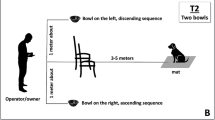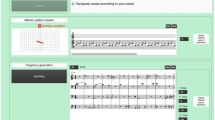Summary
The way in which the tymbals, the tymbal muscles and their nerves function together to produce the natural song patterns, has been studied in four species of Australian cicadas.
-
1.
Cystosoma saundersii Westw., a most unusual cicada, has neurogenic tymbal muscles, which contract simultaneously (Figs. 2, 3a, 4a), giving a pulse repetition frequency (p.r.f.) of only 40/sec. The greatly enlarged abdomen (Kg. 9) acts as a resonant chamber at the low sound frequency (850 Hz) of the natural song.
-
2.
Arunta perulata (Guérin) has neurogenic muscles, contracting simultaneously (Figs. 3b, 4b), giving a low p.r.f. of 65/sec. The powerful song is rendered highly directional by greatly enlarged tymbal covers (Fig. 11) which probably act also as resonant chambers.
-
3.
Psaltoda harrisii (Leach) has neurogenic tymbal muscles, contracting simultaneously (Figs. 3c, 4c) and a high p.r.f., varying from 225–500/sec. Both the IN and the OUT clicks of the tymbal contribute to the p.r.f. but supplementary mechanisms may be required to account for the highest p.r.f. Abdominal movements contribute to the marked amplitude modulation of the natural song.
-
4.
Abricta curvicosta (Germar) has neurogenic tymbal muscles contracting alternately (Figs. 3d, 4d). The tymbal is strongly ribbed so that during the IN movement of the tymbal each rib buckles separately to produce a pulse of sound, thus giving 7–9 sound pulses for each muscle contraction (Figs. 5d, 6d). The p.r.f. of the natural song is 1050/sec.
-
5.
The mechanism described for the first three of these species has not been described before. The mechanism described forAbricta is similar to that of the AmericanMagicicada. There is no correlation between mechanism of sound production and taxonomic classification in cicadas.
-
6.
It is suggested that tymbals with parallel ribs give sound pulses of regular waveform (i.e. with few harmonics) and that tymbals with ribs not parallel give sound pulses of irregular waveform (i.e. with a high harmonic content).
Similar content being viewed by others
References
Aidley, D. J.: Sound production in a Brazilian cicada. J. exp. Biol.51, 325–337 (1969).
Aidley, D. J., White, D. C. S.: Mechanical properties of glycerinated fibres from the tymbal muscles of a Brazilian cicada. J. Physiol. (Lond.)205, 179–192 (1969).
Distant, W. L.: A synonymic catalogue of the Homoptera, Pt. 1, Cicadidae. London: British Museum 1906.
Froggatt, W. W.: Australian insects. Sydney: Brook & Co. 1907.
Goding, F. W., Froggatt, W. W.: Monograph of the Australian Cicadidae. Proc. Linn. Soc. N.S.W.29, 561–670 (1904).
Hagiwara, S.: Neuromuscular mechanism of sound production in the cicada. Physiol. Comp. Oecol.4, 142–153 (1955).
Hagiwara, S., Ogura, K.: Analysis of songs of Japanese cicadas. J. Insect Physiol.5, 259–263 (1960).
Hagiwara, S., Uchiyama, H., Watanabe, A.: The mechanism of sound production in certain cicadas with special reference to the myogenic rhythm in insect muscles. Bull. Tokyo med. dent. Univ.1, 113–124 (1954).
Heath, J. E., Josephson, R. K.: Body temperature and singing in the katydid,Neoconocephalus robustus (Orthoptera, Tettigoniidae). Biol. Bull.138, 272–285 (1970).
Josephson, R. K., Halverson, R. C.: High frequency muscles used in sound production by a katydid. I. Organisation of the motor system. Biol. Bull.141, 411–433 (1971).
Lucas, A. H. S.: On the sound organs of the green cicada,Gyclochila australasiae Donovan. Trans. Roy. Soc. Vict.23, 173–178 (1887).
McCoy, F.: Natural history of Victoria. Prodromus of zoology, Decade V. Melbourne, 1880.
Myers, J. G.: The morphology of the Cicadidae. Proc. Zool. Soc. (Lond.)2, 365–472 (1928).
Pringle, J. W. S.: A physiological analysis of cicada song. J. exp. Biol.31, 525–560 (1954).
Pringle, J. W. S.: The songs and habits of Ceylon cicadas, with a description of two new species. Spolia Zeylan27, 229–238 (1955).
Reid, K. H.: Periodical cicada: mechanism of sound production. Science, N.Y.172, 949–951 (1971).
Young, D.: Analysis of songs of some Australian cicadas. J. Aust. ent. soc. (in press).
Author information
Authors and Affiliations
Additional information
It is a pleasure to thank Mr. R. Geppert, without whose help this work could not have been accomplished, and Mr. K. Underwood for generously making facilities available for the field work at Marbuk Park, Port Macquarie. I am also most grateful to Mrs. C. Vilcins, Mr. R. Jackson and Mr. B. Parr who have given valuable technical assistance.
Rights and permissions
About this article
Cite this article
Young, D. Neuromuscular mechanism of sound production in Australian cicadas. J. Comp. Physiol. 79, 343–362 (1972). https://doi.org/10.1007/BF00696251
Received:
Issue Date:
DOI: https://doi.org/10.1007/BF00696251




